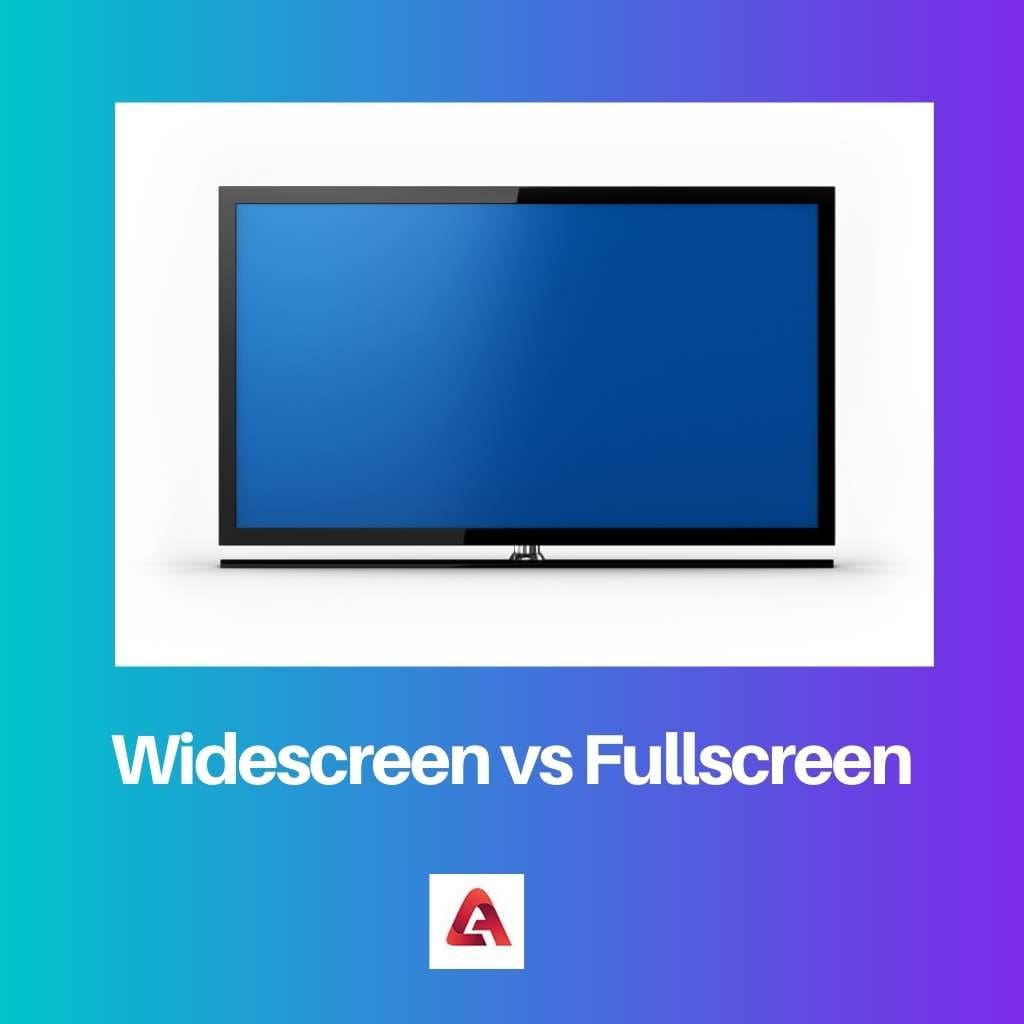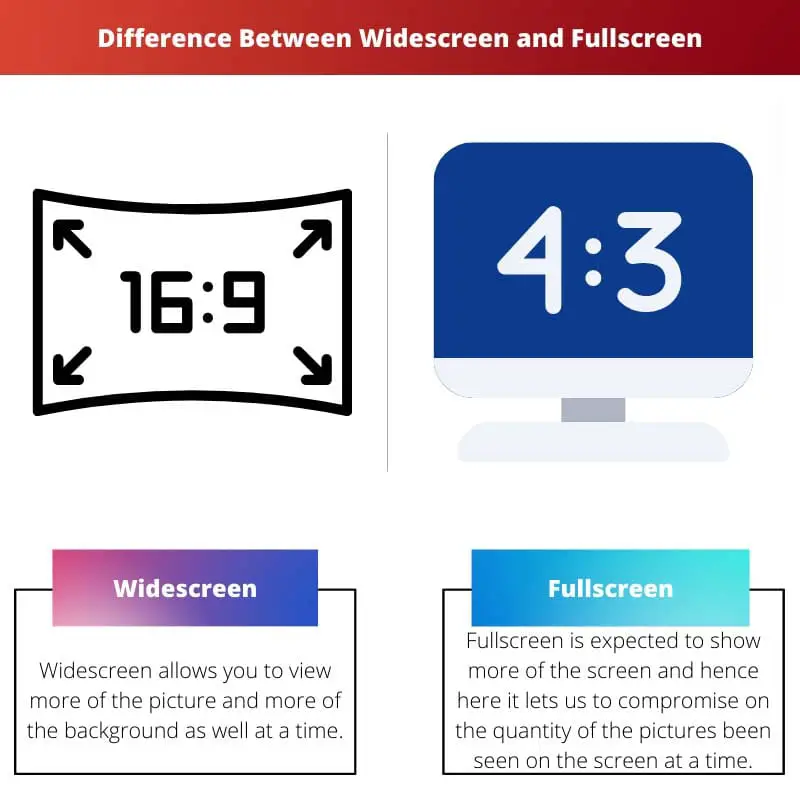Who doesn’t like to play games and watch movies in HD quality? Here, the quality of the screen can make or break your experience. Generally, screens are classified into two types: Widescreen and Fullscreen.
Key Takeaways
- Widescreen has an aspect ratio of 16:9, providing a more panoramic view, whereas fullscreen has a 4:3 aspect ratio, resembling a square.
- Widescreen formats are popular in modern televisions and movies, while fullscreen was the standard in older televisions and some classic films.
- Viewing content in its intended aspect ratio prevents image distortion or cropping, ensuring a better viewing experience.
Widescreen vs Fullscreen
Widescreen refers to a display aspect ratio that is wider than the traditional 4:3 aspect ratio, ranging from 16:9 to 21:9, of older television and computer screens. Fullscreen refers to the display mode where the content is displayed on the entire screen without any black bars or borders around it.

Widescreen allows you to view more of the picture and more of the background as well at a time. It does not have a direct focus on the main subject.
This type of screen is also ideal for gaming to give an immersive experience altogether.
Fullscreen is expected to show more of the screen; hence, it lets us compromise on the quality of pictures being seen on the screen at a time.
It has more focus on the main subject or the character and hence less distraction. It is used on computers or monitors and mobile devices.
This type of screen is ideal for browsing purposes as you can target all the attention to the one point you are looking for.
Comparison Table
| Parameters of Comparison | Widescreen | Fullscreen |
|---|---|---|
| Ratio of screen | 16:9 width:height | 4:3 width:height |
| Resolution | High display resolution | Comparatively low display resolution |
| Focus | Does not focus on the main subject | Focus on the main subject |
| Era of demand | Late 90s and 21st century | Prior than 90s |
| Examples | LCD, LED, HDTV | Mobile screen, old television set |
What is Widescreen?
Widescreen is a type of screen where the images are displayed with a particular ratio (16:9) width to height.
Sometimes it is not necessary to be a 16:9 ratio, any screen wider than 4:3 can be termed as widescreen. Earlier, widescreens were in the ratio of 16:10 later on, and it changed to 16:9 for better quality resolution.
A widescreen television has a screen with a bigger width than the typical fullscreen. This enables the watcher to see a great amount of the picture without stressing their eyes.
In this type of screen, empty black spaces are not seen or are very minimal, giving a high picture quality.
Anyone having a widescreen TV wouldn’t have dark bars on most widescreen motion pictures and would have extremely minuscule ones on a limited handful whose recording viewpoint was considerably more extensive.
Portable and desktop widescreen displays are the types of widescreen displays. Portable screens are smaller than normal televisions but are also significantly more portable.
They are similar to the widescreen displays used on laptops and tablets.

What is Fullscreen?
Fullscreen is a type of screen where the images are displayed in the ratio of 4:3 width to height.
When watching a full-screen film, close to half of the visuals are lost (the left and right parts of the screen), so one doesn’t experience a better quality vision.
The visuals are edited and marginally zoomed in so the visuals fit the smaller TV as contrasted and the more extensive screens when watching at a theatre.
The full-screen hand is a simple 4:3 ratio screen but is stretched as to look like a 16:9 standard ratio. It is used on computers or monitors and mobile devices.
This type of screen is ideal for browsing purposes as you can target all the attention to the one point you are looking for.
At the beginning of the 21st century, manufacturers were more concerned about 16:9 ratio screens and started manufacturing screens of that size.
This made the increase in the demand for widescreen, and the use of the 4:3 ratio (fullscreen) gradually decreased.

Main Differences Between Widescreen and Fullscreen
The main difference between fullscreen and widescreen is that full screen is merely an old-fashioned 4:3 screen that has been stretched out to seem like the 16:9 norm.
- The image is the same size as a 4:3 screen, but it appears to be 16:9, whereas widescreen has a better visual experience because of the 16:9 ratio screen, and also, the image is not being cut down.
- For example, consider watching a wide video screen that will allow you to see more pictures, which means more details and better quality. It has a larger width than normal, giving an eye-catching visual effect that is pleasing to watch.
- While if the same video is watched on the full screen, it will bring your attention only towards the main character or the subject and will only be interesting if you want to notice a particular character in the scene.
- The resolution power is high with the wider screen in comparison to the full screen. The reason behind this is simple: the widescreen needs to fit more pictures or content on the screen at a time.
- While using full-screen mode, there is an option open to choose if you want to view the content at a higher resolution or to reduce its size.

- https://books.google.co.in/books?hl=en&lr=&id=tjvXE7lrywoC&oi=fnd&pg=PP1&dq=info:UFOEqsYVEgcJ:scholar.google.com/&ots=bHe8eERRM9&sig=GWBxUh5OlqXWhyqe3FsqeHWprZE&redir_esc=y#v=onepage&q&f=false
- https://www.osapublishing.org/abstract.cfm?uri=pcAOP-2017-JTu5A.31

Well written article. It explains really well the differences between widescreen and fullscreen
I think the transition from fullscreen to widescreen screens was a natural evolution. The article captures the essence of this transition perfectly.
The impact of high definition content and the need for widescreen displays contributed significantly to this transition.
This evolution has indeed improved the viewer’s experience in many ways. Kudos to the author for presenting it so comprehensively!
This article provided a detailed comparison of widescreen and fullscreen, and how it affects the overall viewing experience. Great work!
I’m not sure I agree with the statement that fullscreen only brings attention to the main subject. There seems to be some bias there.
I feel the same way. The article has some good information but the comparison is slightly biased towards widescreen.